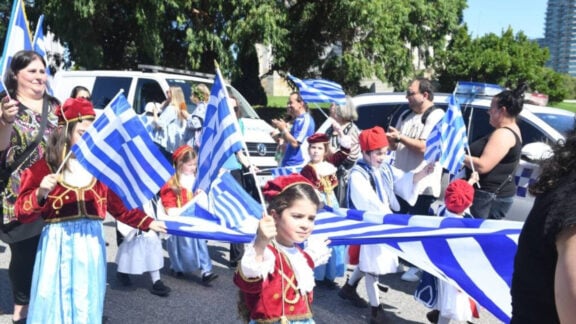In celebrating Greek Independence Day, the national daily broadsheet newspaper in the UK, The Daily Telegraph, asked its travel experts to turn their gaze to Greece, think about their past experiences, and choose their favourite island destinations in Greece.
The islands are the main characteristic of Greece’s morphology and an integral part of the country’s culture and tradition. According to official data from the Greek National Tourism Organisation, Greek sovereign land includes 6,000 islands and islets scattered in the Aegean and Ionian Seas, of which only 227 islands are inhabited. This is a unique phenomenon for the European continent.
The Greek archipelago comprises 7,500 kilometre of the country’s total 16,000 kilometre coastline, offering a highly-diversified landscape. Featuring multi-awarded golden sand, white or black pebble beaches that stretch over many kilometres, sheltered bays and coves, coastal caves with steep rocks and dark-coloured volcanic sand, coastal wetlands, historic monuments, and stunning natural landscapes, it would have been a relatively easy task for the Telegraph to ascertain what they consider to be the best of Greece’s offerings.
Best for Beaches – ZAKYNTHOS
The Ionian Islands can’t be beaten for sandy beaches backed by dramatic coastlines. Myrtos Beach on Kefalonia and Porto Katsiki on Lefkada are among the most photogenic, but according to the Telegraph, Shipwreck Bay on Zakynthos, only accessible by boat, trumps them both – even if it does get a bit crowded.
“Visitors to Zakynthos should avoid the boozy corners of the south coast and stick to the beautiful, un-spoilt north and mountainous west of the island,” says Telegraph Travel’s Joanna Symons.
“Or base yourself on the pine-forested Vasilikos Peninsula in the south-east, most of which has been protected from large-scale development because of the loggerhead turtles that breed on Gerakas beach. Gerakas itself is a perfect curve of golden sand. Those turtles know how to pick a good spot,” she adds.
Best for families – CORFU (Kérkyra)
With the passage of time, the island may have changed but visitors can still feel the spirit of a distant glorious past. With its rich multicultural heritage, historic monuments, stunning natural landscape, crystal clear beaches, and excellent weather all year round, Corfu is one of the most cosmopolitan Mediterranean destinations.
Interestingly, unlike the rest of Greece, Corfu (Kérkyra) never fell under Ottoman rule and oppression. Due to the successive dominations of the Venetians, the French, and the British over the centuries, the island has primarily become part of the Western rather than the Levantine world.
“If I could give a child a gift, I would give him my childhood,” said Gerald Durrell, the author and conservationist, shortly before his death in 1995 – a ringing endorsement for Corfu where the Durrells spent four years from 1935-1939. Much has changed since his time there, but away from the excesses of Kavos in the south, you’ll still find idyllic, sleepy spots. Tourist development is quarantined on certain coastal patches and once inland you really seem to be on another island, even another era,” says Marc Dubin, the Telegraph’s Greece expert.
Best for history and culture – DELOS
“The birthplace of Apollo according to mythology, Delos boasts some of the most extensive remains from the golden Hellenistic age (and earlier) of classical Greece. The entire island – a UNESCO World Heritage Site – consists of ruins, which have been systematically unearthed since 1872, including temples, statues, mosaics, and a theatre. It is not possible to stay on the island, visitors arrive by boat from nearby Mykonos.”
Best for hotels – MYKONOS
Named after the grandson of Apollo, Mykonos is Greece’s most famous cosmopolitan island; a whitewashed paradise in the heart of the Cyclades. Setting out on a journey to discover a fascinating world where glamour meets simplicity, the Telegraph Travel experts were impressed by the island’s luxurious and trendy resorts.
“Greek hotels have a reputation for being rustic – not so on trend. Mykonos has some of the most stylish boutique properties around,” says Marc Dubin, who recommends Cavo Tagoo near Hora for those who decide to experience the island’s best.
“Built atop an abandoned quarry in 1985 by owner-architect Paris Liakos, then renovated thoroughly in 2007, this ‘barefoot chic’ complex set the standard for all the cutting-edge lodging that followed,” he says.
Best for food – CRETE
Crete is the largest island in Greece and the fifth largest in the Mediterranean Sea, where visitors can admire the remnants of brilliant civilisations, explore glorious beaches and impressive mountainscapes, fertile valleys and steep gorges and become part of the island’s rich gastronomic culture.
According to the Telegraph, “Crete’s southerly location gives it the longest growing season in Greece. It produces a surfeit of edible goods – you’ll even find avocados and bananas.”
Marc Dubin says: “Crete has figured prominently in the revival in Greek cuisine, drawing on such local ingredients as flavoured rusks, fresh or cured meats, wild edible weeds, and of course raki or tsikoudia, the famous local distilled clear spirits made from grape pressings in October.”
“Agritourism is catching on in Greece, especially on Crete, and a working farm is the best place to sample authentic regional cooking,” says Telegraph Travel’s Jane Foster.
Best for wine – KEFALONIA
The biggest Ionian island – immersed in lush green scenery, breathtaking beaches – and crystal clear waters of greenish-blue colours is a beloved destination to many. According to the Telegraph’s travel experts, apart from its pristine beaches – with Myrtos among the best in the whole of Greece – culinary traditions, picturesque villages, and the wine is a drawcard. Despite the fact that there’s wonderful wine to be quaffed in Crete and Santorini, Kefalonia’s wine, whose Robola winery is responsible for the tipple of choice of drunken Father Arsenios in Louis de Bernières’ classic novel Captain Corelli’s Mandolin, is being praised.
Best for peace and quiet – KOUFONISSIA
Hidden away between the larger Cycladic Islands of Naxos and Amorgos, the two tiny islets, Ano (Upper) Koufonissi and Kato (Lower) Koufonissi, which are separated by a 200-metre sea channel, were named Koufonissia, meaning hollow islands, due to the existing huge caves, which gave the impression to pirates who viewed them from a distance, that the islands were hollow.
According to the Telegraph’s contributor Jane Foster, whilst Kato Koufonissi remains uninhabited, Ano Koufonissi, with its whitewashed Cycladic cottages, has a buzzing little community of 366 residents.
“Locals live mainly from fishing – it is claimed that there are more boats than residents – there are no real roads and hardly any cars, so everyone either walks or cycles. Before 1980, there was no electricity either, and it is only over the last decade that Koufonissi has become a popular escape with Athenians in search of an unpretentious and inexpensive summer holiday. It’s much loved by yachters too, who moor up their sailing boats along the seafront, to unwind after visiting the noisier and glitzier islands of Santorini and Mykonos.”
Best for eco-warriors – HYDRA
Considered by many as the gem of the Saronic Islands of Greece, Hydra, which shot to fame in 1957 as the location for the film Boy on a Dolphin starring Sophia Loren, remains endearingly time-warped according to Marc Dubin.
“As a listed architectural reserve, all new construction is (theoretically) banned, and it’s blissfully free of motor vehicles except for a few miniature rubbish trucks – photogenic donkeys (or mules) for most of the haulage. The clip-clop of the beasts’ hooves on the marble pavement and their drovers’ cries are very much part of the soundtrack here,” he writes.
Best for hiking – ANDROS
The northernmost island of the Greek Cyclades archipelago is well-known for its mountainous, breathtaking scenery. The Telegraph Travel’s regular contributor, John Gimlette recalls a trip back in 2000.
“We marched along ancient pavements bounded by massive stone-panelled walls. We stumbled into orange groves or splashed along streams colonised by terrapins and operatic frogs. Then we climbed into great, crackle-dry valleys, home only to pine martens. Finally, we clambered up through almond groves and mulberry forests to the Panachrantos Monastery. Once, 300 monks had lived there, but only two remained, living in a state of blissful decrepitude,” Gimlette recalls.
Best for Couples – SYMI
Although Santorini, the precious gem of the Aegean, is a strong contender, Symi got the Telegraph’s vote as far as couples visiting goes.
“It has one of the most picturesque harbours in the country, crowded with pastel-coloured houses, bars, tavernas, and chic boutiques and dozens of tiny beaches accessible only by boat.
“Symi is a rugged gem with a harbour of crumbling neoclassical mansions. It offers a wonderful local experience and some of the best food on the Greek islands,” says the Telegraph’s Francesca Syz.
Best for alternatives – SKYROS
Skyros, the most remote and undeveloped of the Sporades Island, is a hotspot for holistic holidays and the Telegraph Travel’s Sophi Butler recommends Atsitsa Bay, which offers yoga, sailing, life-coaching, music, sketching, painting, singing, dancing, and various drop-in activities.
Best for traditional island life – KARPATHOS
Midway between Rhodes and Crete, Karpathos has been in and out of the holiday brochures for years but never quite hit the big time.
“As a result it’s a haven for peace-seekers, with pretty beaches and coves (some accessible only by boat), good walking in dramatic scenery, and quirky villages,” explains Robin Gauldie.
Best for villas and monasteries – SKOPELOS
According to the Telegraph, on a Greek island holiday, cool, stone-floored villas are infinitely preferable to hotels, and Skopelos, the setting for the film adaptation of Mamma Mia!, has some wonderful options. Telegraph Travel’s Oliver Smith suggests Villa Aetoma, a 10-minute drive from Skopelos town. The island is also known for its monasteries.
Best for views – SANTORINI
“Kastellorizo, Greece’s easternmost island, is utterly gorgeous, but it’s hard to look beyond Santorini,” The Telegraph Travel experts write.
“It’s best approached by sea. As your arriving craft manoeuvres over the impossibly midnight blue waters of the caldera, the sheer lava cliffs of the caldera lip, layered in varicoloured rock, loom overhead, with white houses on top like a dusting of snow,” says Marc Dubin.
“It’s one of the spectacles of the Med, as is the reverse practice of staring out over the caldera waters from up top – something not lost on the strangely assorted clientele of honeymooners, cruise-ship patrons, and backpackers.”
Best for Bond fans – NISYROS
“Several Greek islands have found fame thanks to film – including Skopelos (Mamma Mia!) and Amorgos (The Big Blue). James Bond fans should head for Nisyros, however, whose spectacular volcano appeared in Moonraker.”
Best for gay travellers – LESVOS (Mytilini)
According to the Telegraph Travel experts the word ‘lesbian’ is derived from the birthplace of the poet Sappho, noted for the expressed affection for women in her work. Subsequently, the island and the town of Eresos, where she was born are popular with gay travellers.
“The island has an abundance of good beaches and restaurants,” says Marc Dubin.
“The best of the former, on the south-facing coast, are Skala Eressou (which is a full-on resort) and Vatera, which is much quieter. Good restaurants are scattered across the island,” he says.
Best for nightlife – RHODES
Although Kos, Corfu, and Mykonos all stand out in this regard, The Telegraph Travel experts went for the island of the knights, the capital of the Dodecanese; Rhodes.
“Head to the fast-changing old-quarter bars around Platia Arionos and along Miltiadou,” suggests Marc Dubin.
Best for watersports – LEFKADA
“Large bays and consistently blustery winds attract droves of sailors and windsurfers to Lefkada, with the coastal towns of Vassiliki and Nydri popular spots for hiring boats and boards. The island has plenty more to recommend it, from its glorious beaches to its steep interior. The gorgeous former capital of Karya is a highlight.”
Best for religious history – PATMOS
“Tradition (and Friedrich Hölderlin’s famous 1802 poem Patmos) asserts that St John the Evangelist, ‘O Theologos’ in Greek, penned The Bible’s Book of Revelations on Patmos just after 95AD,” says Marc Dubin.
“Though, lately, scholars reckon he was a completely different individual than the author of one of the four Gospels. A millennium later, the monk Christodoulos founded the imposing fortified monastery of the saint on the island’s summit. This monastery is the main attraction on the island and lends itself a ‘palpably spiritual atmosphere; but there are also excellent beaches, arty boutiques and wonderful views to lure holidaymakers.”





